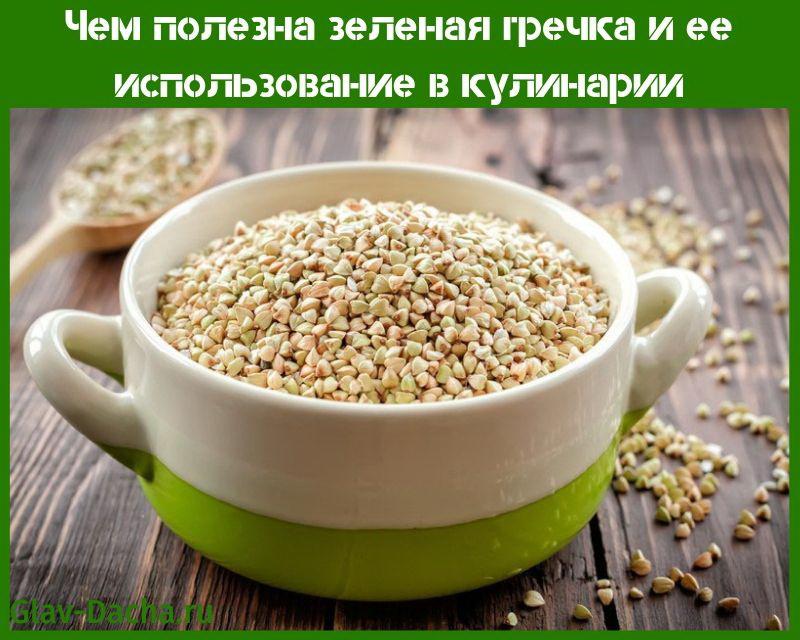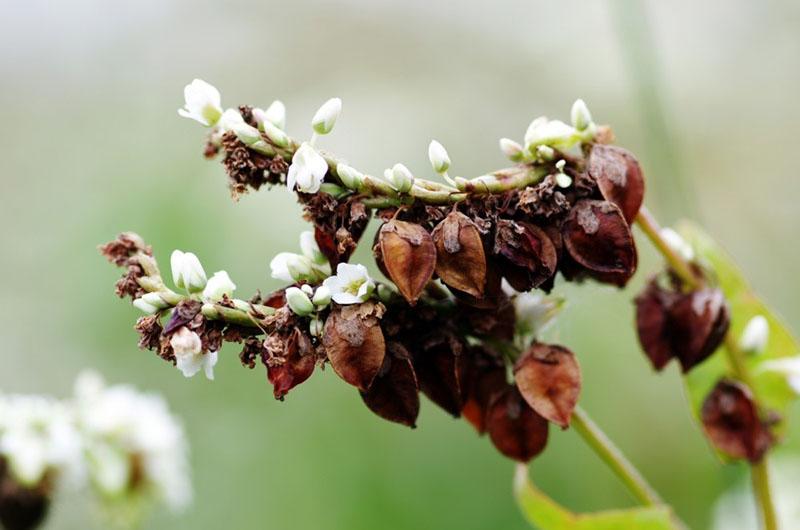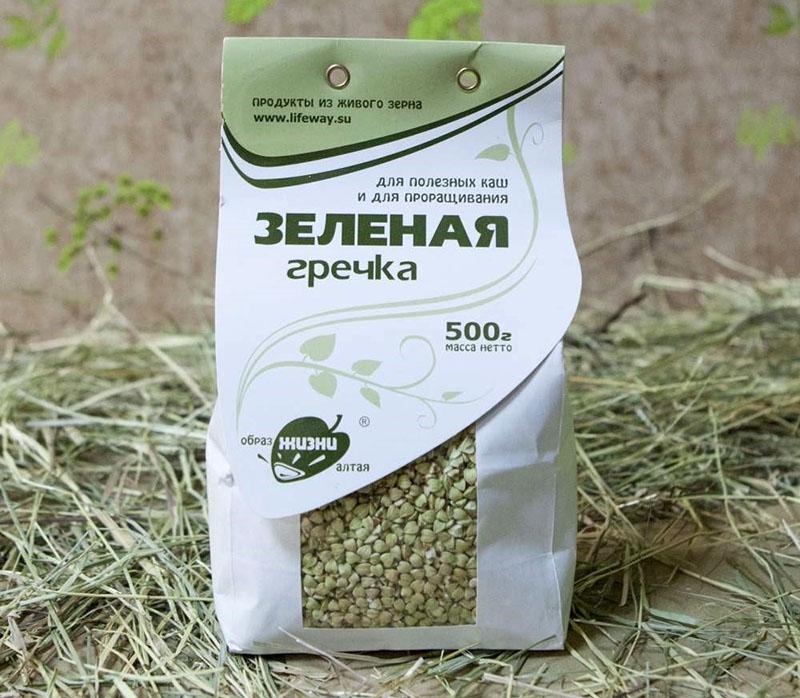Why green buckwheat is useful and its use in cooking
 Green buckwheat is raw, unprocessed buckwheat. Such a product has recently become popular due to the discovered beneficial properties and effects on the body. It is actively included in the menu by those who follow proper and balanced nutrition. Baked goods and other buckwheat dishes can be consumed by people with gluten intolerance.
Green buckwheat is raw, unprocessed buckwheat. Such a product has recently become popular due to the discovered beneficial properties and effects on the body. It is actively included in the menu by those who follow proper and balanced nutrition. Baked goods and other buckwheat dishes can be consumed by people with gluten intolerance.
Buckwheat appeared in Russia thanks to trade relations with the Greeks, hence it got its name. For the first time, they began to grow it in India. And the method of roasting cereals before packaging and selling was invented in the United States. So the product acquired a more attractive appearance and aroma. However, scientists have found that when cooked, a super-useful product loses some of its qualities.
Main characteristics


Features of green buckwheat:
| Name | Characteristic |
| Grain color | from light olive to sandy; |
| Treatment | undergoes mechanical processing, during which the core leaves the rigid shell;
does not undergo heat treatment, due to which the kernel retains the ability to germinate; |
| Benefit | contains an easily digestible protein, a set of micro and macro elements, vitamins; |
| Caloric content (100 g) | 295 kcal; |
| Protein | 10.8 g; |
| Fats | 3.2 g; |
| Carbohydrates (complex) | 54.4 g; |
| Method of use | fresh (sprouted), as a side dish, in salads, in the form of pancakes, bread, buckwheat muffins; |
| Storage period | up to a year in a ventilated room with limited penetration of sunlight. |
You can distinguish weighed cereals by color and smell. Fried buckwheat is more aromatic and has a rich brown color.
Beneficial features
 Eating not fried buckwheat increases hemoglobin levels, helps to improve bowel function. The protein contained in grains is completely absorbed by the body, does not cause a feeling of heaviness in the stomach.
Eating not fried buckwheat increases hemoglobin levels, helps to improve bowel function. The protein contained in grains is completely absorbed by the body, does not cause a feeling of heaviness in the stomach.
The product contains the following nutrients:
| Trace elements | Vitamins |
| calcium; | IN 1; |
| magnesium; | IN 2; |
| iodine; | FROM; |
| manganese; | PP. |
| phosphorus; | |
| a small amount of aluminum, nickel, boron, cobalt. |
In sprouted grains, the amount of ascorbic acid and nutrients increases.
How green buckwheat is prepared
An important question raised by green buckwheat is how to cook in order to preserve all the nutrients?
There are several ways to use this product:
- from the washed dry grains they make flour for healthy baking;
- sprouted groats are added to salads, consumed fresh for breakfast, used to prepare fermented dough (analogue of yeast dough);
- cereal steamed with boiling water is used in the form of porridge;
- during the preparation of the soup, the cereal is added last, allowing it to go under the lid until cooked;
- prepare gluten-free buckwheat bread.
When preparing a "live" product, it is desirable to use the minimum exposure to temperature. When frying, intensive boiling, a small part of the nutrients is lost.
Healthy porridge recipe
 In order for the green buckwheat porridge to retain its properties and taste good, it is recommended to cook it as follows:
In order for the green buckwheat porridge to retain its properties and taste good, it is recommended to cook it as follows:
- Pour a glass of cereal (200 g) into a sieve, rinse under running water;
- Boil two glasses (400 ml) water;
- Pour the washed cereal into a metal pan with a tight lid, pour boiling water over;
- Cover the container with a lid and wrap in towels;
- Let it brew for 2 to 3 hours.
To get buckwheat for breakfast, it is better to steam it overnight. In the morning, it is enough to warm up the porridge, add milk and fruit.
Green buckwheat flour
 Fine, malleable green buckwheat flour is suitable for preparing gluten-free dishes: pancakes for carnival, homemade bread, pancakes, muffins. Compared to cereals, the energy value of flour increases: it contains 328 kcal, 12.6 g of proteins, 3.3 g of fat and 62 g of carbohydrates. The flour is white with a slight greenish tinge, the aroma is not as intense as that of fried buckwheat flour. The most important difference from ordinary buckwheat flour is that green flour is more plastic, it has high binding qualities and fermentation ability.
Fine, malleable green buckwheat flour is suitable for preparing gluten-free dishes: pancakes for carnival, homemade bread, pancakes, muffins. Compared to cereals, the energy value of flour increases: it contains 328 kcal, 12.6 g of proteins, 3.3 g of fat and 62 g of carbohydrates. The flour is white with a slight greenish tinge, the aroma is not as intense as that of fried buckwheat flour. The most important difference from ordinary buckwheat flour is that green flour is more plastic, it has high binding qualities and fermentation ability.
To make flour from groats at home, you must:
- rinse and dry the kernels well on a towel;
- grind the required amount in a coffee grinder.
The resulting flour can be added to sauces and puree soups as a thickener.
How green buckwheat germinates
 There are no contraindications for the use of sprouted grains: they can be used in childhood, adulthood and old age. The product enhances immunity, improves digestion, and helps preserve youth. Germinating green buckwheat at home takes 15 - 18 hours.
There are no contraindications for the use of sprouted grains: they can be used in childhood, adulthood and old age. The product enhances immunity, improves digestion, and helps preserve youth. Germinating green buckwheat at home takes 15 - 18 hours.
It is carried out according to the following scheme:
- A glass of green cereal is washed under cold water several times.
- Pour into a deep bowl.
- Pour in clean water so that the groats are covered with water with a margin of 2 cm on top.
- After the grains stand in water for 3 to 4 hours, the liquid is drained.
- The bowl is removed to a dark place for germination, stirring occasionally.
- After 12-14 hours, white sprouts appear on the kernels - this means that the product is ready for use.
Do not cook a lot of sprouted grains at once, they do not have a long shelf life.
Green buckwheat for making bread
 Green buckwheat bread is easy to make at home. The recipe requires not buckwheat flour, but self-sprouted kernels. The product is prepared for about an hour and a half, has the benefits and taste of natural buckwheat, does not contain gluten. The bread has a slightly moist, tender crumb and crispy crust.
Green buckwheat bread is easy to make at home. The recipe requires not buckwheat flour, but self-sprouted kernels. The product is prepared for about an hour and a half, has the benefits and taste of natural buckwheat, does not contain gluten. The bread has a slightly moist, tender crumb and crispy crust.
Required Ingredients:
- sprouted green buckwheat - 3 cups;
- salt - a third of a teaspoon;
- water - 1 glass;
- sunflower seeds, pumpkin, sesame seeds - half a glass;
- vegetable oil - half a teaspoon.
Cooking method:
- Buckwheat is germinated, washed;
- Pour three glasses of buckwheat into the blender bowl, add a glass of water, interrupt until smooth;
- The resulting mass is poured into a metal container, covered with a towel, left for a day at room temperature for fermentation;
- After the mass has fermented, add salt and half a portion of the seeds to it, mix well;
- Pour into a mold, sprinkle with the remaining seeds on top, set to bake for 80 minutes at 180 °.
You can determine the readiness of the bread with a wooden match: if, when piercing the bread, it comes out dry, then the bread is baked.